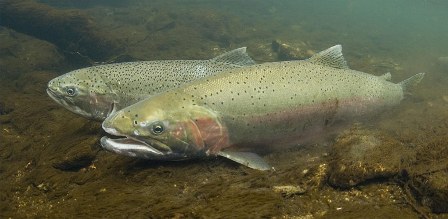Salmon, trout and steelhead in California face a grim future if present trends continue, according to a study released this week, and climate change is the primary culprit.
The report, titled “Fish in Hot Water,” estimates that 45 percent of the state’s salmonid populations will disappear over the next 50 years unless steps are taken to help the fish. Nearly three-quarters will be gone in the next hundred years if current trends continue.
The analysis, from California Trout and the University of California, Davis, considered prospects for 32 populations of salmon, trout and steelhead in the state. The findings have implications beyond the fate of those fish.
“Their health and their resilience indicates healthy waters, which is important for all Californians’ drinking water, agriculture, commerce, and the health of the people and the environment in which we live,” said Curtis Knight, California Trout’s executive director. “The decline of the fish indicates the decline of all of our water. That’s important to all Californians.”
Salmon, trout and steelhead need cold water to survive. As the climate warms, fewer rivers and streams will be cool enough for the fish.
A warming climate also is expected to reduce the upwelling action of the California Current. That upwelling brings a bounty of nutrients from the ocean depths to the surface—nutrients that are critical for ocean-going salmon and steelhead.
Rising sea levels will also harm the fish, according to the report, as saltwater inundates estuaries and lagoons that provide key habitat for juveniles.
Other threats include agricultural activities that require large quantities of water and thus reduce streamflows, and competition from nonnative species such as brown and brook trout.
One native species has already been extirpated from California. The last bull trout in the state was documented in 1975.
The report lays out a number of steps that can be taken to help the fish survive in the state. Those include safeguarding the most productive habitat, including the Smith and Eel river systems.
Restoring meadows high in the Sierra Nevada would result in a slower release of water during California’s increasingly hot summers and would help counter the effect of reduced snowpacks.
Taking steps to mimic natural habitats and processes can also help fish species, the report says. That could include letting some farmland flood when not in use, providing habitat for juvenile fish.
“This report should rightly be considered an alarm bell, but it should also be seen as a roadmap for how we can correct course to better support native aquatic species,” said Peter Moyle, associate director of the Center for Watershed Science at UC Davis and the report’s lead author. “Thanks to ongoing scientific research, we now know what to do–and where–to improve the plight of native fish.”
The study serves as an update to a similar report issued in 2008. Since that time, more than four out of five populations of salmon, steelhead and trout in California have declined, according to the most recent report.


